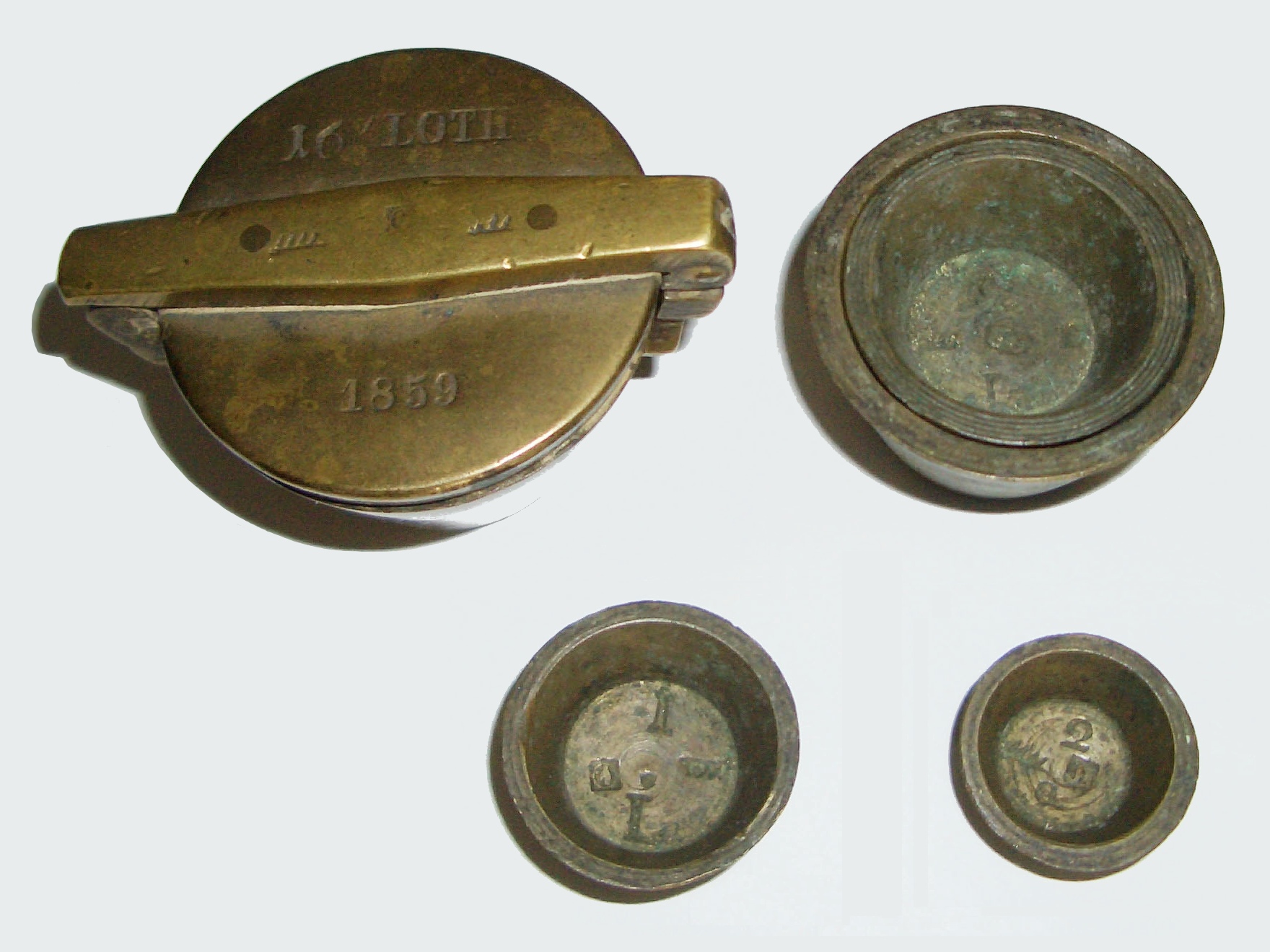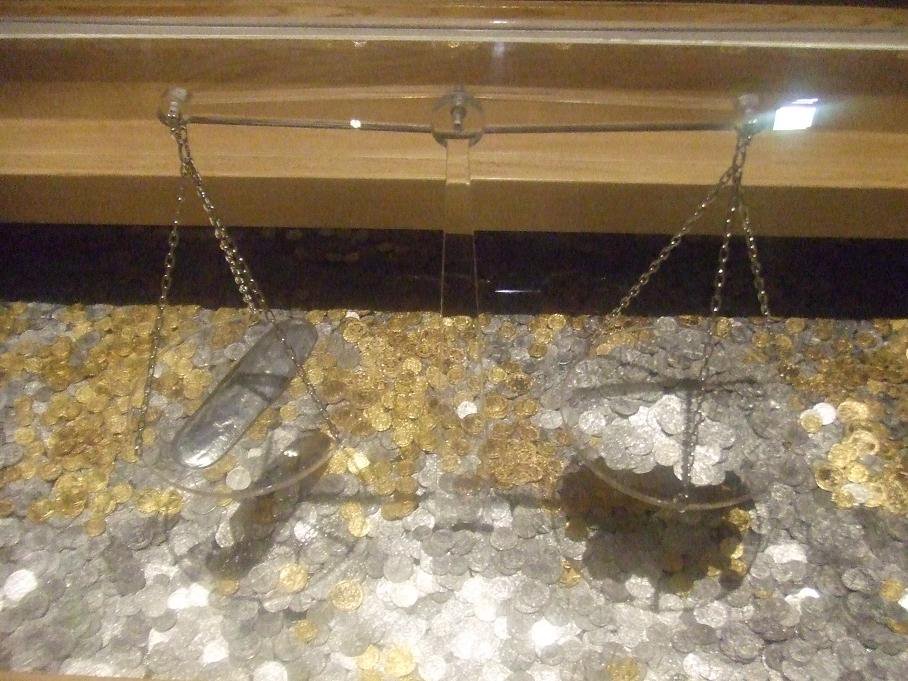|
Zolotnik
A zolotnik (, abbr.: zol.) is an obsolete Russian unit of weight, equal to 0.1505 avoirdupois ounces, 0.13715 troy ounce, or 4.2658 grams (about 65.83 grains). Used from the 10th to 20th centuries, its name is derived from the Russian word ''zoloto'', meaning gold. As a unit, the zolotnik was the standard for silver manufacture, much as the troy ounce is currently used for gold and other precious metals. This unit was originally based on a coin of the same name. The zolotnik circulated in the Kievan Rus until the 11th century; it was equal in weight to the Byzantine Empire's solidus. Relation to other units The Russian pound was known as the funt. There were 96 zolotniki in a pound. A smaller unit, the lot, was equal to three zolotniki. There were 96 dolya in a single zolotnik. The zolotnik was also used to measure fineness of precious metals (gold, silver, platinum). In this case, the ratio zolotnik/funt was meant, so one zolotnik meant . For example, 14-karat (58.33%) ... [...More Info...] [...Related Items...] OR: [Wikipedia] [Google] [Baidu] |
Obsolete Units Of Measurement
This is a list of obsolete units of measurement, organized by type. These units of measurement are typically no longer used, though some may be in limited use in various regions. For units of measurement that are unusual but not necessarily obsolete, see List of unusual units of measurement. For units of measurement that are humorous in nature, see List of humorous units of measurement. Area * Antsingae – a unit of area, smaller than the bunarium. * Bunarium (plural "bunaria") – a unit of area, equal to about 120 Hectare#Are, ares or 12,000 square metres * Carucate * Cawnie * Decimal (unit), Decimal * Dessiatin * Ground (unit), Ground * Hide (unit), Hide * Juchart * Jugerum * Katha (unit), Katha * Lessa (unit), Lessa or Lecha * Marabba * Morgen * Oxgang * Pari (unit), Pari – a unit of area equal to about 1 hectare * Quinaria * Tathe * Virgate Energy, etc. * Poncelet – unit of power * Sthène – unit of force * * Length * Ald (unit), Ald * Alen (unit of length), Al ... [...More Info...] [...Related Items...] OR: [Wikipedia] [Google] [Baidu] |
Byzantine Empire
The Byzantine Empire, also known as the Eastern Roman Empire, was the continuation of the Roman Empire centred on Constantinople during late antiquity and the Middle Ages. Having survived History of the Roman Empire, the events that caused the fall of the Western Roman Empire in the 5th centuryAD, it endured until the fall of Constantinople to the Ottoman Empire in 1453. The term 'Byzantine Empire' was coined only after its demise; its citizens used the term 'Roman Empire' and called themselves 'Romans'. During the early centuries of the Roman Empire, the western provinces were Romanization (cultural), Latinised, but the eastern parts kept their Hellenistic culture. Constantine the Great, Constantine I () legalised Christianity and moved the capital to Constantinople. Theodosius I, Theodosius I () made Christianity the state religion and Greek gradually replaced Latin for official use. The empire adopted a defensive strategy and, throughout its remaining history, expe ... [...More Info...] [...Related Items...] OR: [Wikipedia] [Google] [Baidu] |
Pood
''Pood'' ( rus, пуд, r=pud, p=put, plural: or ) is a unit of mass equal to 40 Funt (mass), ''funt'' (, Russian pound). Since 1899 it is set to approximately 16.38 kilograms (36.11 pound (mass), pounds). It was used in Russia, Belarus, and Ukraine. ''Pood'' was first mentioned in a number of 12th-century documents. Unlike ''Funt (mass), funt'', which came at least in the 14th century from , (formerly written * ) is a much older borrowing from Late Latin "pondo", from Classical "pondus". Use in the past and present Together with other units of weight of the Obsolete Russian weights and measures, Imperial Russian weight measurement system, the USSR officially abolished the ''pood'' in 1924. The term remained in widespread use until at least the 1940s. In his 1953 short story "Matryona's Place", Aleksandr Solzhenitsyn presents the ''pood'' as still in use amongst the Khrushchev-era Soviet peasants. Its usage is preserved in modern Russian in certain specific cases, e.g., in ... [...More Info...] [...Related Items...] OR: [Wikipedia] [Google] [Baidu] |
Obsolete Tatar Units Of Measurement
Traditional Tatar units of measurement were used by Tatars until 1924 but became obsolete when the Soviet Union adopted the metric system. The Tatar system shares many units with the Russian system (e.g. and ), which is close to the English (the Russian system under Peter the Great was redefined relative to the English system), therefore a is relatively equal to an inch. This list includes their Tatar language names. Length * (дюйм), thumb = 30 mm * (вершок) = 44.45 mm * (foot) ** 1 = 12 = 304.8 mm * or (пядь) ** 1 = 4 = 177.8 mm * (аршин) ** 1 = 4 = 16 = 28 = 711.2 mm * or (сажень) ** 1 = 3 = 7 = 2.133 m * (верста) ** 1 = 500 = 1.0668 km * or ** 1 = 6-7 = 6.400-7.467 km * (миля), geographical mile ** 1 = 7 = 7.467 km * , the distance a horse travels without stops ** 1 = 15–25 km * , a day of riding ** 1 = 35 = 37.338 km * , the distance a horse travels in ... [...More Info...] [...Related Items...] OR: [Wikipedia] [Google] [Baidu] |
Obsolete Russian Units Of Measurement
Historical Russian units of measurement were standardized and used in the Russian Empire and after the Russian Revolution, but were abandoned after 21 July 1925, when the Soviet Union adopted the metric system. The Tatar system is very similar to the Russian one, but some names are different. The Polish system is also very close to the Russian. The system existed since Kievan Rus', but under Peter the Great, the Russian units were redefined relative to the English system.Шостьин Н. А. Очерки истории русской метрологии XI – начала XX века. М.: 1975. Until Peter the Great the system also used Cyrillic numerals, and only in the 18th century did Peter the Great replace it with the Hindu–Arabic numeral system. Length The basic unit was the Russian ell, called the ''arshin'', which came into use in the 16th century. It was standardized by Peter the Great in the 18th century to measure exactly twenty-eight English inches (). Thu ... [...More Info...] [...Related Items...] OR: [Wikipedia] [Google] [Baidu] |
Polish Zloty
Polish may refer to: * Anything from or related to Poland, a country in Europe * Polish language * Polish people, people from Poland or of Polish descent * Polish chicken * Polish brothers (Mark Polish and Michael Polish, born 1970), American twin screenwriters * Kevin Polish, an American Paralympian archer Polish may refer to: * Polishing, the process of creating a smooth and shiny surface by rubbing or chemical action ** French polishing, polishing wood to a high gloss finish * Nail polish * Shoe polish * Polish (screenwriting), improving a script in smaller ways than in a rewrite See also * * * Polishchuk (surname) * Polonaise (other) A polonaise ()) is a stately dance of Polish origin or a piece of music for this dance. Polonaise may also refer to: * Polonaises (Chopin), compositions by Frédéric Chopin ** Polonaise in A-flat major, Op. 53 (, ''Heroic Polonaise''; ) * Polon ... {{Disambiguation, surname Language and nationality disambiguation pages ... [...More Info...] [...Related Items...] OR: [Wikipedia] [Google] [Baidu] |
Fineness
The fineness of a precious metal object (coin, bar, jewelry, etc.) represents the weight of ''fine metal'' therein, in proportion to the total weight which includes alloying base metals and any impurities. Alloy metals are added to increase hardness and durability of coins and jewelry, alter colors, decrease the cost per weight, or avoid the cost of high-purity refinement. For example, copper is added to the precious metal silver to make a more durable alloy for use in coins, housewares and jewelry. Coin silver, which was used for making silver coins in the past, contains 90% silver and 10% copper, by mass. Sterling silver contains 92.5% silver and 7.5% of other metals, usually copper, by mass. Various ways of expressing fineness have been used and two remain in common use: ''millesimal fineness'' expressed in units of parts per 1,000 and '' karats'' or ''carats'' used only for gold. Karats measure the parts per 24, so that 18 karat = = 75% gold and 24 karat gold is considered ... [...More Info...] [...Related Items...] OR: [Wikipedia] [Google] [Baidu] |
Dolya (unit)
Historical Russian units of measurement were standardized and used in the Russian Empire and after the Russian Revolution, but were abandoned after 21 July 1925, when the Soviet Union adopted the metric system. The Tatar system is very similar to the Russian one, but some names are different. The Polish system is also very close to the Russian. The system existed since Kievan Rus', but under Peter the Great, the Russian units were redefined relative to the English system.Шостьин Н. А. Очерки истории русской метрологии XI – начала XX века. М.: 1975. Until Peter the Great the system also used Cyrillic numerals, and only in the 18th century did Peter the Great replace it with the Hindu–Arabic numeral system. Length The basic unit was the Russian ell, called the ''arshin'', which came into use in the 16th century. It was standardized by Peter the Great in the 18th century to measure exactly twenty-eight English inches (). Thus ... [...More Info...] [...Related Items...] OR: [Wikipedia] [Google] [Baidu] |
Lot (unit)
The Lot (formerly also written ''Loth'') was a unit of measurement of mass, which was mainly used in German-speaking states of the Holy Roman Empire and in Scandinavia. It was replaced in the German Reich in 1868/69/72, in Austria in 1871/76 and in Switzerland in 1875/77 by the metric unit of measurement, the gramme. But in the early 20th century it was still used as a popular unit of measure in cooking and baking recipes. An imprecise but clear rule of thumb is that a ''lot'' corresponds to a "spoonful". Old ''Lot'' In Germany, Austria and Switzerland, the following weight system was traditionally used: (trading) '' Pfund'' = 1 ''Lot'' = 4 ''Quents'' = 16 ''Pfennig'' weights = 32 ''Heller'' weights The ''Lot'' had different weights in the various German states depending on the definition of the ''Pfund'' ("pound"); its definition also varied over time. However it was mostly set at between 14 g and 18 g. Some examples: * 14.606 g before May 1856 in Prussia, A ... [...More Info...] [...Related Items...] OR: [Wikipedia] [Google] [Baidu] |
Funt (mass)
The pound or pound-mass is a unit of mass used in both the British imperial and United States customary systems of measurement. Various definitions have been used; the most common today is the international avoirdupois pound, which is legally defined as exactly , and which is divided into 16 avoirdupois ounces. The international standard symbol for the avoirdupois pound is lb; an alternative symbol (when there might otherwise be a risk of confusion with the pound-force) is lbm (for most pound definitions), # ( chiefly in the U.S.), and or ̶ (specifically for the apothecaries' pound). The unit is descended from the Roman (hence the symbol ''lb'', descended from the scribal abbreviation, '). The English word ''pound'' comes from the Roman ('the weight measured in '), and is cognate with, among others, German , Dutch , and Swedish . These units are now designated as historical and are no longer in common usage, being replaced by the metric system. Usage of the unqualifie ... [...More Info...] [...Related Items...] OR: [Wikipedia] [Google] [Baidu] |





